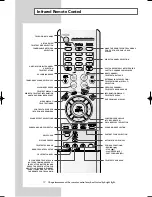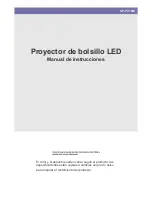
EN-21
Viewing video images (continued)
C. Projecting images
Preparation:
• Remove the lens cap.
1. Put the projector into standby mode by pressing the main power switch. The POWER indicator lights up red.
• If the projector was turned off before the lamp was cooled down suffi ciently last time, the fan may start rotating
and the POWER button may not work after the main power switch is turned ON. (The STATUS indicator blinks
green.) After the fan stops rotating, press the POWER button to turn back on the POWER indicator.
2. Turn on the power of the connected video equipment.
3. Press the POWER button.
• It may take about 1 minute for the lamp to light up.
• The lamp fails to light up on rare occasions. In such a case, wait for a few minutes and then try again.
• Do not cover the lens with the lens cap while the lamp is on.
• After the POWER button is pressed, the image may fl icker before the lamp becomes stable. This is not a prod-
uct malfunction.
• Regardless of the setting of LAMP MODE in the INSTALLATION menu, the STANDARD lamp mode is activated
by default whenever the projector is turned on. When LAMP MODE has been set to LOW, the lamp mode
changes from STANDARD to LOW about 1 minute after turn-on.
• The projector starts warming up when the POWER button is pressed. During the warm-up process, images
may appear dark and no commands are accepted.
• By blinking red, the STATUS indicator indicates that the lamp should be replaced soon. Replace the lamp
when the STATUS indicator blinks red. (See page 38.)
• After the POWER button is pressed, a white bar may appear on the right edge of the screen for about 1
second, but this is not a malfunction.
4. Press the ZOOM/FOCUS button to display “FOCUS”.
5. Adjust with the
W
or
X
button to get a fi ne picture.
• When the ENTER button is pressed while “FOCUS” is displayed, the adjustment mode is switched between
FAST and STEP. When FAST is selected, the speed of focus controlled by the
W
or
X
button becomes fast,
and it becomes slow when STEP is selected.
6. Select an input source.
• Press the VIDEO button on the projector or the VIDEO or S-VIDEO button on the remote control that is
corresponding to the terminal in use.
• The input source is switched between VIDEO and S-VIDEO at every press of the VIDEO button on the projector.
• You cannot change the input source while the menu is being displayed.
• Though it may take some time before an image is displayed on the screen depending on the type of the input
signal, such symptom is not a malfunction.
• Some images become easier to view when the setting of aspect ratio is changed. (See page 17.)
• When projecting images from a DVD player that is connected to the COMPUTER/COMPONENT VIDEO DVI-D
(HDCP) terminal, press the COMPUTER button on the projector to select DVI or press the DVI-D (HDCP) button
on the remote control.
• When projecting images from a DVD player that is connected to the COMPUTER/COMPONENT VIDEO IN
1 or COMPUTER/COMPONENT VIDEO IN 2 terminal, press the COMPUTER button on the projector or the
COMPUTER 1 or COMPUTER 2 button on the remote control.
• When COMPUTER 1 or COMPUTER 2 is chosen as the source, images supplied from the computer may
fl icker. Press the
W
or
X
button on the remote control to reduce fl icker, if it occurs.
• When an image supplied from a video device to the COMPUTER1, COMPUTER2 or DVI input source is
displaced, select VIDEO SIGNAL adjustment mode as described in “AUTO POSITION button” on page 16.
7. Adjust the position of the projector to keep an appropriate projection distance with which images are projected in
their specifi ed sizes.
8. Adjust the position of the projector so that the projector and the screen are perpendicular to each other. (See page
10.)
• When the projector cannot be positioned perpendicularly to the screen, adjust the projection angle. (See page
11.)
Main power switch
POWER button
VIDEO button
COMPUTER button
ZOOM/FOCUS button
LENS SHIFT button
COMPUTER 1, 2 buttons
POWER button
DVI-D(HDCP) button
S-VIDEO button
VIDEO button
ZOOM/FOCUS button
LENS SHIFT button
















































